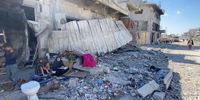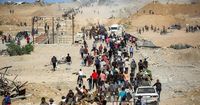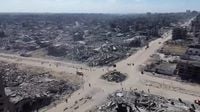With the ink barely dry on a fragile ceasefire agreement, the battered streets of Gaza City have witnessed a somber homecoming. On October 16, 2025, tens of thousands of Palestinians—many of them displaced for months—began the arduous trek back to what remains of their neighborhoods, clutching little more than hope and the clothes on their backs. The Associated Press reports that the vibrant avenues once teeming with life have been rendered nearly unrecognizable, transformed into a haunting landscape of twisted metal and pulverized concrete after two years of relentless warfare.
As the first rays of dawn broke over the northern Gaza Strip on Friday, families streamed northward, many on foot, their faces etched with fatigue and uncertainty. According to The Independent, the route home was lined with the ashen skeletons of bombed-out buildings and mangled skylines, painting a stark portrait of the devastation. "Your body shivers from the scale of the destruction," said Mahmoud Al-Kafarneh, a 37-year-old returnee. For many, the journey was not just about reclaiming lost property but about seeking the comfort of familiar places—though few found anything they recognized.
In the eastern Gaza City neighborhood of Shujaiya, scenes of heartbreak and resilience unfolded in equal measure. Hajar Al-Sawwaf, 78, sat cross-legged before the battered remnants of her home, surrounded by grandchildren and the scant shelter of torn blankets and tarps. "We fled with only the clothes on our backs," she told Drop Site. "And now, we’ve come back again, and God willing, we’ll stay here. By God, we’ll die here…Everything is gone, but praise be to God, we’ve returned." Her words echoed the determination of many Palestinians who, despite the ruins and the risks, have resolved to rebuild their lives where their memories—and their losses—are rooted.
Shujaiya, once among Gaza City’s most populous neighborhoods, now lies in utter ruin. Every building, according to local accounts, has either been destroyed or heavily damaged. Families have pitched makeshift tents atop the rubble, clearing debris by hand to carve out tenuous living spaces. Clotheslines stretch between twisted rebar; children play among the ruins; adults queue for charity kitchens, though food remains desperately scarce. "There’s no life left, no money left, no food," said Bilal Hameed, a displaced resident who returned despite warnings. "Should I expose myself to danger or expose myself to humiliation, to degradation, to being insulted? No. Dead is dead—but if I must die, I’d rather die with dignity than live humiliated. I have to return to my area and stay steadfast here."
The risks are far from theoretical. Parts of Shujaiya lie within the so-called “yellow line,” an invisible boundary marking the Israeli military’s withdrawal under the ceasefire’s first phase. Yet, even after the ceasefire began, violence has not entirely ceased. Drop Site reports that at least 23 Palestinians have been killed by Israeli forces since the agreement took effect, including five in a single attack on Shujaiya on October 14. Israel’s defense minister, Israel Katz, defended the military’s actions: "The IDF operates in accordance with directives and enforces a clear policy of preparedness along the yellow line—which includes over 50% of Gaza’s territory. The enforcement policy is unequivocal: for every violation, an immediate response. Yesterday, terrorists who attempted to approach and cross were thwarted—and so it will be in the future as well."
For those returning, the challenges go well beyond security. The Week, citing UN satellite data, reports that a staggering 92% of Gaza’s housing units have been damaged or destroyed. As Israel’s offensive intensified in September, entire neighborhoods were razed, displacing 90% of the population. The basic infrastructure—water, sewerage, and temporary shelter—is in tatters. Before rebuilding can even begin, an estimated 50 million tonnes of rubble must be cleared, a daunting task made even more perilous by the presence of unexploded ordnance, human remains, and the threat of armed militants still lurking in underground tunnels.
The sheer scale of the destruction is hard to fathom. A United Nations Development Program official told reporters that the rubble in Gaza could form a mound 12 meters high across New York’s Central Park or be enough to build thirteen Egyptian pyramids. Yet, heavy equipment and machinery needed for clearance are being kept out by Israeli restrictions, compounding the suffering of those trying to recover loved ones still buried beneath the ruins. "In this area, there are no neighbors left," said Mohammad Al-Sawwaf, another returnee. "If you happen to find one neighbor still around, it’s like finding a treasure. The rest, as you can see, are under the rubble. No one has been pulled out yet. They’re still beneath the rubble. There are no excavators, no life. But still, we will create life, and we will live. Even if they destroy the entire world."
The humanitarian crisis deepens by the day. Acute malnutrition and illness are rampant, with many residents like Hajar Al-Sawwaf reporting dramatic weight loss and deteriorating health due to famine and the lack of clean water. The Guardian notes that, although aid agencies were promised 600 trucks of humanitarian supplies per day, only a fraction have been allowed through. The ongoing closure of the Rafah border crossing and restrictions on fuel, medicine, and food have turned survival into a daily struggle.
The cost of reconstruction looms large: $53 billion, according to The Week, with international donors wary that funds could be siphoned off by corruption or end up in the hands of Hamas. Yet, for most Gazans, the prospect of rebuilding is not a matter of economics but of identity and dignity. "This area holds all our memories and our entire life," Mohammad Al-Sawwaf told Drop Site. "Even if it’s destroyed, even if it’s in ruins, we’ll sit here on top of the rubble…Even if they demolish everything over our heads, we’re staying. Where can we go?"
Despite the devastation, the spirit of Gaza’s people remains unbroken. As families salvage what they can from the debris, they cling to the hope that, one day, life will return to their neighborhoods—not as it was, perhaps, but as a testament to their resilience. The road ahead is daunting, fraught with danger and uncertainty, but for many, there is simply no alternative. Their roots run too deep, and their resolve, forged in adversity, is not easily shaken.






